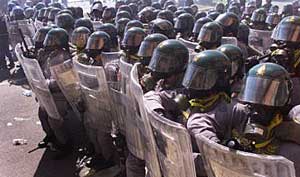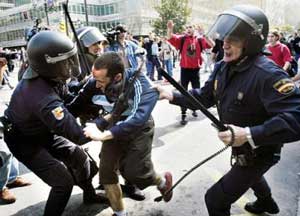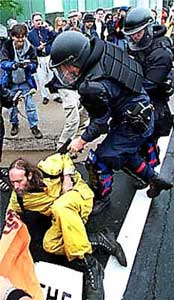 |
| "God-damned hippies!" |
Weapons that can incapacitate crowds of
people by sweeping a lightning-like beam of electricity
across them are being readied for sale to military and
police forces in the US and Europe.
At present, commercial stun guns target
one person at a time, and work only at close quarters.
The new breed of non-lethal weapons can be used on many
people at once and operate over far greater distances.
But human rights groups are appalled by
the fact that no independent safety tests have been carried
out, and by their potential for indiscriminate use.
 Taser
success rates by distance Taser
success rates by distance
The weapons are designed to address the
perceived shortcomings of the Taser, the electric-shock
gun already used by 4000 police departments in the US
and undergoing trials with some police forces in the UK.
It hits the victim with two darts that
trail current-carrying wires, which limit its range to
a maximum of seven metres (see graphic). As a single shot,
short-range weapon, the Taser is of little use in crowd
control. And Tasers have no effect on vehicles.
Ionised gas
These limitations are beginning to be
overcome. Engineers working for the US Department of Defense's
research division, DARPA, and defence companies in Europe
have been working out how to create an electrically conductive
path between a gun and a target without using wires.
A weapon under development by Rheinmetall,
based in Dorf, Germany, creates a conducting channel by
using a small explosive charge to squirt a stream of tiny
conductive fibres through the air at the victim (New Scientist
print edition, 24 May 2003).
 Meanwhile,
Xtreme Alternative Defense Systems (XADS), based in Anderson,
Indiana, will be one of the first companies to market
another type of wireless weapon. Instead of using fibres,
the $9000 Close Quarters Shock Rifle projects an ionised
gas, or plasma, towards the target, producing a conducting
channel. It will also interfere with electronic ignition
systems and stop vehicles. Meanwhile,
Xtreme Alternative Defense Systems (XADS), based in Anderson,
Indiana, will be one of the first companies to market
another type of wireless weapon. Instead of using fibres,
the $9000 Close Quarters Shock Rifle projects an ionised
gas, or plasma, towards the target, producing a conducting
channel. It will also interfere with electronic ignition
systems and stop vehicles.
"We will be able to fire a stream
of electricity like water out of a hose at one or many
targets in a single sweep," claims XADS president
Peter Bitar.
Solid-state lasers
The gun has been designed for the US Marine
Corps to use for crowd control and security purposes and
is due out in 2005. It is based on early, unwieldy technology
and has a range of only three metres, but an operator
can debilitate multiple targets by sweeping it across
them for "as long as there is an input power source,"
says Bitar.
 XADS
is also planning a more advanced weapon which it hopes
will have a range of 100 metres or more. Instead of firing
ionised gas, it will probably use a powerful laser to
ionise the air itself. The idea has been around for decades,
says LaVerne Schlie, a laser expert at the US Air Force
Research Lab in Kirtland, New Mexico. It has only become
practical with advances in high-power solid-state lasers. XADS
is also planning a more advanced weapon which it hopes
will have a range of 100 metres or more. Instead of firing
ionised gas, it will probably use a powerful laser to
ionise the air itself. The idea has been around for decades,
says LaVerne Schlie, a laser expert at the US Air Force
Research Lab in Kirtland, New Mexico. It has only become
practical with advances in high-power solid-state lasers.
"Before, it took a laser about the
size of two trucks," says Schlie. "Now we can
do it with something that fits on a tabletop."
 The
laser pulse must be very intense, but can be brief. So
the makers of the weapons plan to use a UV laser to fire
a 5-joule pulse lasting just 0.4 picoseconds - equating
to a momentary power of more than 10 million megawatts. The
laser pulse must be very intense, but can be brief. So
the makers of the weapons plan to use a UV laser to fire
a 5-joule pulse lasting just 0.4 picoseconds - equating
to a momentary power of more than 10 million megawatts.
This intense pulse - which is said not
to harm the eyes - ionises the air, producing long, thread-like
filaments of glowing plasma that can be sustained by repeating
the pulse every few milliseconds. This plasma channel
is then used to deliver a shock to the victims similar
to a Taser's 50,000-volt, 26-watt shock.
Instrument of torture
 HSV
Technologies of San Diego, California is also working
on stun and vehicle-stopping shock weapons with ranges
of over 100 metres. And another company, Ionatron of Tuscon,
Arizona, is due to supply a prototype wireless vehicle-mounted
weapon to the US Department of Defense by the end of 2004. HSV
Technologies of San Diego, California is also working
on stun and vehicle-stopping shock weapons with ranges
of over 100 metres. And another company, Ionatron of Tuscon,
Arizona, is due to supply a prototype wireless vehicle-mounted
weapon to the US Department of Defense by the end of 2004.
But the advent of wireless stun weapons
has horrified human rights groups. Robin Coupland of the
Red Cross says they risk becoming a new instrument of
torture. And Brian Wood of Amnesty International says
the long-range stun guns could "inflict pain and
other suffering on innocent bystanders".
And there are safety concerns. Of the
30,000 times US police officers have fired Tasers, in
40 instances people stunned by them later died. The deaths
have been attributed to factors such as overdoses of drugs
and alcohol, or fighting with officers, rather than the
electric shock.
In a statement, Taser International chief
Rick Smith said: "In every single case the medical
examiner has attributed the direct cause of death to causes
other than the Taser." Amnesty is not convinced,
however, and wants an independent study of the effects
of all existing and emerging electric-shock weapons.
|